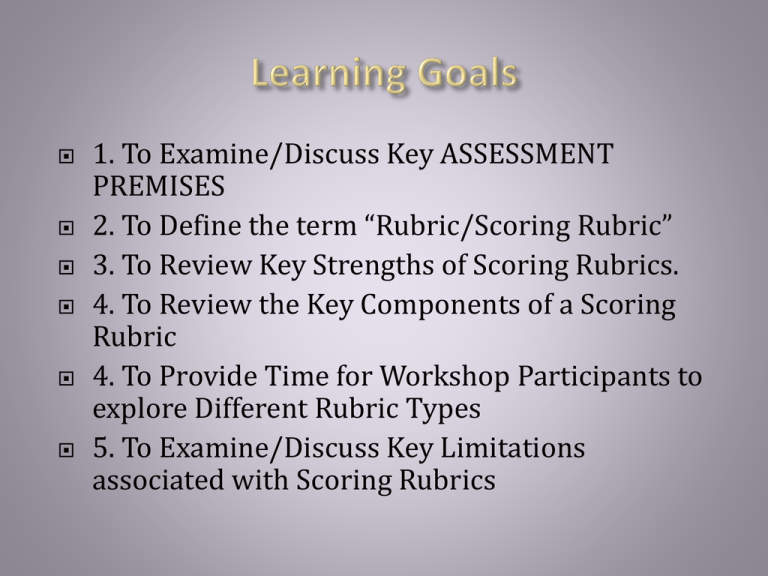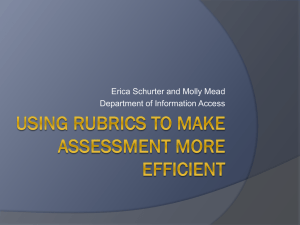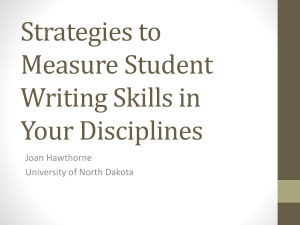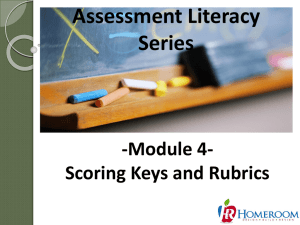Using a Rubric
advertisement

1. To Examine/Discuss Key ASSESSMENT PREMISES 2. To Define the term “Rubric/Scoring Rubric” 3. To Review Key Strengths of Scoring Rubrics. 4. To Review the Key Components of a Scoring Rubric 4. To Provide Time for Workshop Participants to explore Different Rubric Types 5. To Examine/Discuss Key Limitations associated with Scoring Rubrics 1. 2. The primary goal for TEACHING is to stimulate (student) LEARNING. Assessment, rightly conceived, is a TEACHING and LEARNING TOOL. Assessment measure learning and stimulates learning. UNK eLuncheon Thursday, November 14, 2013 Students are (should be) the most important users of assessment results. Feedback from assessment tasks can help students in setting, goals, assuming responsibility for their own LEARNING, and becoming more independent LEARNERS. Assessments impact how students feel about LEARNING. 1. 2. What type(s) of assessment is most likely to encourage / maximize student learning? What type of assessment most powerfully aligns with the knowledge, skills, or dispositions/attitudes that are the key learning goals? In the mid-15th century, rubric referred to headings of different sections of a book. In recent decades, educators created a new meaning: teachers who scored students' written compositions began to use the term to describe the rules that guided their scoring. The use of rubrics expanded – now used to assess the quality of student work and program quality in a myriad of disciplines. A Scoring Rubric: Communicates expectations of quality around a task. Delineates consistent criteria for grading. Allows teachers and students alike to evaluate criteria, which can be complex and subjective. Provides a basis for self-evaluation, reflection, and peer review. Strives to provide an accurate and fair assessment Fosters understanding and indicates a way to proceed with subsequent learning/teaching. Focuses upon a specific learning goal, target, or outcome (Example: Writing Quality)—PRODUCT or PROCESS Outcomes Specifies one or more dimensions that serve as the basis for judging the quality of a student’s work (Example: Ideas, Organization, Word Choice, Fluency, Voice, Conventions) Provides an explanation for each dimension. Establishes a scale of values on which to rate each dimension (Numeric (1-2-3-4); Words (Unacceptable-Acceptable-Exemplary). Are all Dimensions of Equal Value? Analytic Rubric: Specifies at least two dimensions to be assessed at each performance level and provides a separate score for each. Holistic Rubric: Provides a single score based on an overall impression of a student's performance on a task. Key dimensions are collapsed into one statement/category. WHICH WORKS BEST FOR YOU? 1. 2. 3. 4. Find and adapt an existing rubric! Much good work has already been done—the wheel may have already been invented! Evaluate the usefulness of the rubric. Does it align with the outcome(s) being assessed? Is it Useful? Feasible? Manageable? Practical? Collect samples of student work that exemplify each point on the scale or level? Share Examples with Students. Expect to revise the rubric to make it better. 1. Hand out the rubric with the assignment so students will know your expectations and how they'll be graded. 2. Use the rubric to grade student work and return the rubric with the grading on it. 3. Consider involving students in creating the rubrics –foster increased student ownership? 4. To facilitate student ownership, ask students to use the rubrics to assess the quality of their work and/or the work of peers. Conceptual Problems – Alfie Kohn Practical Problems – A Math Problem Do the Math Problem! There is no (good) choice! If I pick the four scale, there is nothing in between 75% and 100% which means that in order to get ‘honors’ (over 80%), I have to assign a perfect grade. If I pick the four scale, there is nothing in between barely passing 50% and 75%. That’s a large leap. If I pick the five scale, it is awfully tempting to just pick 60% as it is a pretty average grade that lots of kids might fit. If I pick the five scale, there is nothing between 40% and 60%, so someone who I’m not comfortable with getting 80% will get the same 3/5 mark as someone I was not comfortable with giving a 40% failing grade. I guess I could give half marks with the 4 and 5 scales. Where ut do I draw the line? Assessing Outcomes – With a Rubric! Outstanding – All Learning Goals were Effectively Addressed and the Food was Good Good – Most Learning Goals were adequately addressed and the Food was Good Okay – I don’t remember the Learning goals but the Food was Good. Ouch – The Food was Good and I forget what the presentation was about!







